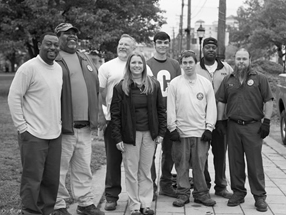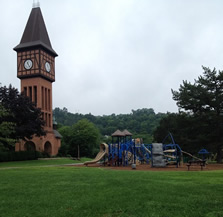The City of Covington faces a unique set of challenges when it comes to managing risk. In a municipality of close to 450 employees which includes seasonal labor, the City of Covington is responsible for the management and safety of the police, fire, and public works departments and non-union staff.
The City of Covington is deeply committed to keeping its employees safe on the job, so we spoke with Risk Manager Bob Stark to get his perspective on the city’s safety efforts.
KEMI: Tell us about your background before assuming responsibility for the city’s risk management program?
Bob: Before coming to the City of Covington, I was the environmental safety coordinator for Northern Kentucky Water District and safety chairperson for the Tennessee/Kentucky American Water Works Association (AWWA), a volunteer firefighter and EMT for 23 years and a hazardous materials technician for nine years.
Eight years ago I was hired by the City of Covington to manage the workers’ compensation claims, and in May 2015 I moved into the operations department while continuing my role as the city’s risk manager.
 KEMI: As the risk manager for the City of Covington, what are your safety responsibilities?
KEMI: As the risk manager for the City of Covington, what are your safety responsibilities?
Bob: My task is to oversee the safety programs and assist with improving our facilities infrastructure. This includes managing everything from fire alarms and sprinkler systems to helping coordinate the installation of new roofs and windows on older buildings.
With our safety programs, the largest department to manage afrom a safety perspective is public works which includes six different work groups:
- Arborists – tree climbers who also deal with exposure to herbicides and pesticides, so we make sure that they’re properly protected and have the correct certifications;
- Beautification – this group removes graffiti, trims weeds, picks up litter (including things such as used syringes);
- Fleet – takes care of all of the vehicles and small equipment;
- Parks and Facilities – manage our parks, playgrounds and swimming pools (including handling chemicals to treat the water).
- Right-of-Way – are responsible for all the concrete and blacktop work;
- Solid Waste – which includes our transfer station
KEMI: As a municipality, the City of Covington is in a unique situation when it comes to building an effective safety program. What challenges have you faced and what were the outcomes?
Bob: When I handled the workers’ compensation claims for the city, we couldn’t get beyond 30 days without a lost-time injury. I spoke with our human resource director and proposed an incentive program. My plan was to set a goal of three consecutive months without any lost-time injuries, so when they reached this goal I rewarded the departments with some type of meaningful acknowledgment.
At one point, we reached 659 days without a lost-time injury in our Public Works Department, so we had a pig roast for them to celebrate. We also had a Kona Ice truck, and corn-hole games; it was a fun party! I let the employees know that we appreciate them working safely and the event was definitely a success. Our incentive programs have been very effective in getting employees motivated.
My biggest ongoing challenge is that there is turnover in many of the top positions in the city. Since I’ve been here, we’ve had five police chiefs, five fire chiefs, five or six EMS directors, three or four public works directors, and we’ve have had multiple mayors and city council members. By the time I have a good working relationship with a person, there is a change of personnel and I have to start building new relationships. And to me, upper management support is crucial. Having someone at the top supporting our safety initiatives is very important.
Another challenge is managing communication with numerous agencies such as unions, insurance companies, and state/local agencies. When an employee is injured, we work hard to ensure that all steps are in compliance with workers’ compensation statutes. Thankfully, everyone shares the same goal of getting the injured employee healthy and back to work.
KEMI: What would you say has been one of the greatest successes of the safety program in the City of Covington?
Bob: Within a few years after switching to KEMI, our experience modifier (commonly known as an e-mod) dropped from a 1.54 to 0.87. Our city was able to save significant revenue by reducing premium expenses, and we also received several dividend checks from KEMI as a result of our safety success.
 What would you consider one of the most effective tools at managing safety with an organization of this size?
What would you consider one of the most effective tools at managing safety with an organization of this size?
Bob: I use safety audits to take a complete look at the safety of our operations. I conduct one safety audit in the spring and then come back in the fall and evaluate each department to see if they’ve completed the safety recommendations. Our operations department is also responsible for making sure things are in safe working order and sets aside money for repairs without burdening each department and their respective budgets.
KEMI: What KEMI services have you found to be most beneficial in your role as a risk manager?
Bob: I have loved working with KEMI and believe we are a well-oiled machine working together. When a claim is reported, we all make sure to pay attention to the injured worker’s needs and ensure we are working well together.
Additionally, Eli Roberts from KEMI’s Loss Education and Safety team contributes to our monthly meetings. If we ever have a significant injury in the workplace, Eli and I go to the work site, study the environment, make recommendations, and then work with the person in charge to add safety measures aimed at reducing or eliminating the hazards. Eli has also helped teach safety classes (such as forklift safety training) and has been great to work alongside. These resources are all very valuable to us.
KEMI: What is on the horizon for the City of Covington when it comes to making safety a top priority?
Bob: There is a large fireworks display in northern Kentucky and Cincinnati on the Ohio River. There will be a lot of people behind the scenes planning the event ranging from emergency management to our police, fire and public works departments. We will have firefighters, the U.S. Coast Guard, the Hamilton County Sheriff’s Department and others with boats on the river, so there are several meetings necessary to orchestrate logistics and develop strategies to be both proactive with safety and, if necessary, react in case of an emergency. Our top priority is to make sure the event remains as safe as possible for everyone involved.
To learn more about the City of Covington, visit http://www.covingtonky.gov/. For free workplace safety resources from KEMI, visit www.worksafeky.com.

